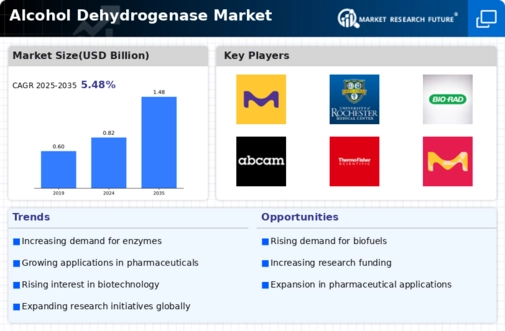Market Growth Projections
The Global Alcohol Dehydrogenase Market Industry is projected to experience substantial growth over the next decade. With an anticipated market size of 0.82 USD Billion in 2024, the industry is expected to expand to 1.48 USD Billion by 2035. This growth trajectory indicates a compound annual growth rate (CAGR) of 5.49% from 2025 to 2035. Such projections reflect the increasing demand for research and therapeutic solutions related to alcohol metabolism, driven by rising health concerns and advancements in biotechnology. The market's expansion is likely to attract further investments and innovations in the field.
Advancements in Biotechnology
The Global Alcohol Dehydrogenase Market Industry is benefiting from advancements in biotechnology, which enhance the understanding and manipulation of alcohol dehydrogenase enzymes. Innovations in genetic engineering and recombinant DNA technology allow for the development of more effective enzyme variants, which could lead to improved therapeutic applications. These advancements not only facilitate research but also open avenues for the creation of novel alcohol dehydrogenase-based products. As biotechnology continues to evolve, the market is expected to expand, aligning with the projected growth trajectory of 0.82 USD Billion in 2024 to 1.48 USD Billion by 2035.
Regulatory Support for Alcohol Research
The Global Alcohol Dehydrogenase Market Industry is supported by regulatory initiatives that promote research into alcohol metabolism and its health implications. Governments and health organizations are increasingly recognizing the need for comprehensive studies on alcohol-related health issues, leading to funding opportunities and collaborative research efforts. This regulatory support is crucial for advancing the understanding of alcohol dehydrogenase and its role in various metabolic pathways. As more resources are allocated to this field, the market is likely to benefit from enhanced research capabilities, contributing to its growth and development.
Growing Awareness of Personalized Medicine
The Global Alcohol Dehydrogenase Market Industry is increasingly shaped by the growing awareness of personalized medicine. As healthcare shifts towards individualized treatment plans, the role of genetic variations in alcohol dehydrogenase becomes more pronounced. Understanding how different individuals metabolize alcohol can lead to tailored interventions that improve patient outcomes. This trend is likely to drive demand for diagnostic tools and therapies that consider genetic factors, thereby fostering growth in the market. The potential for personalized approaches in treating alcohol-related conditions may significantly influence the industry's trajectory in the coming years.
Rising Prevalence of Alcohol-Related Disorders
The Global Alcohol Dehydrogenase Market Industry is significantly influenced by the rising prevalence of alcohol-related disorders, including alcohol use disorder and liver diseases. As these conditions become more common, there is a growing need for effective diagnostic and therapeutic solutions that target alcohol metabolism. Alcohol dehydrogenase plays a pivotal role in the metabolism of ethanol, and understanding its function can lead to better treatment options. The increasing burden of alcohol-related health issues is likely to drive investments in research and development, further propelling market growth in the coming years.
Increasing Demand for Alcohol Metabolism Research
The Global Alcohol Dehydrogenase Market Industry is experiencing heightened interest due to the increasing demand for research into alcohol metabolism. This research is crucial for understanding the physiological effects of alcohol consumption and its implications for health. As awareness of alcohol-related health issues grows, funding for studies examining the role of alcohol dehydrogenase in metabolic processes is likely to increase. This trend is reflected in the projected market growth, with the industry expected to reach 0.82 USD Billion in 2024 and 1.48 USD Billion by 2035, indicating a compound annual growth rate (CAGR) of 5.49% from 2025 to 2035.






















Leave a Comment